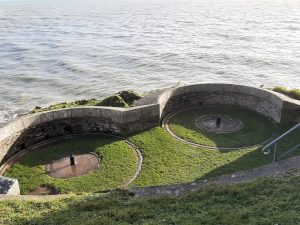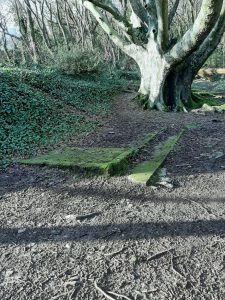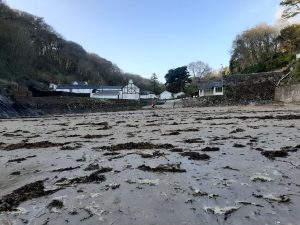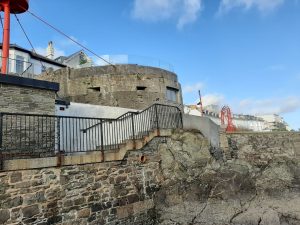Fowey’s Second World War Fortifications
Fowey’s natural deep harbour has meant that it has been a busy and strategically important trading port for hundreds of years.
At the outbreak of World War 2 the building of coastal defences in the area became a priority. The Royal Navy were in overall charge of the Harbour but also stationed in the town were various Army units, the Royal Air Force and of course the American troops. Fowey became one of the main ports in Cornwall for loading ammunition for the US 29th Division which landed on Omaha Beach on D-Day and because of this it was a well-defended town and harbour. Due to the number of troops and the license to export ammunition Fowey became a “secret port” and heavy penalties were in place to prevent photographs being taken in restricted areas. Fowey did not go unscathed during the war and was targeted by enemy bombers on several occasions when bombs, incendiary devices and mines were dropped. In 1944 the town played its part in the D Day landings and accommodated units of men from Landing Craft Tank and Landing Craft Infantry units in the preparation of the liberation of troops from France. Over 1000 Americans were based in the town prior to embarking for France in the June of that year. Many of the survivors rescued were brought back to Fowey for treatment before being sent on to Falmouth. Due to the very large number of service personnel stationed in Fowey, British and American, the town was well served with medical facilities. The US Navy having a 100-bed hospital and a hospital training school.
Some of the WW2 coastal defence structures and their remains are still visible, and some have been lost to time.
The Coastal Defences. Quite a few of the pillboxes were built in very inaccessible places along the cliffs and getting materials up or down to the sites must have been done by boat or sheer manpower.
On approaching the harbour there were two Searchlight Batteries, one on the Fowey side and one on the Polruan side. Neither of these have survived. At the entrance to the harbour, St Catherine’s Castle which was built during the reign of Henry VIII, had been repurposed to accommodate gun emplacements, the remains of which are still visible.

Also located on the headland were two 4.7 inch guns. Once was located on the rocks below the Castle and the other one behind the castle in what is now Covington Woods. In the woods and adjacent Allday’s Fields, a military camp was erected to accommodate the men required to man the guns and searchlights. The remains of some of these buildings can be seen and are readily accessible.

On the side of the woods overlooking Ready Money beach is a block building which was the toilet block for the soldiers. The entrance to the estuary was then finished off with a controlled minefield being lad which must have been a worry for ships still having to pass through that area of sea. A minefield was also laid up on Allday’s Fields on clifftops. One would assume it was there for the protection of the men stationed at the military camp that abutted Covington Woods.

At the mouth of the estuary a controlled minefield was laid
On the other side of Ready Money beach was another Searchlight Battery which was situated in the grounds of Point Neptune House. The structure has been demolished but the circular fortification where it probably stood can still be seen from St Catherine’s Castle. The beach itself was defended by the placing the hulk of the “Helena Ann” in 1940 as a blockship and an anti-aircraft battery was located at the rear of the beach in a front garden. Across the entrance to the beach a tubular defence barrier was erected.
Further into the harbour on the west side were placed two six pounder guns. One of which was sited in front of 14 Tower Park and the second one was positioned on the cliffs at Pollysfoot Cover. Both have been demolished although the base of the No 2 gun at Pollysfoot can still be seen. The building and manning of this gun was via a wooden bridge that was erected from The Crab Pot on the Esplanade
In the grounds below Fowey Hotel that run down to the estuary the summer house was used as a Royal naval look out post. On the cliffs between the two guns placements was a pillbox which was situated on the cliffs below St Catherine’s Court. Because of its inaccessibility the pillbox is still there and can be clearly seen from the river but access from above is not possible.
At Whitehouse where the ferry runs to Polruan, a round pillbox can be easily seen. This is not accessible as it is situated in a private garden. The row of buildings behind the pillbox on The Esplanade were used as Military headquarters during the war.

On the Town Quay were placed Tank Traps consisting of Dragons Teeth and the Buttermarket under The King of Prussia was used as an Air Raid Shelter.
The railway lines operating into Fowey from Lostwithiel and Par were closed to passenger services for “Security Reasons” during the war. China clay was still being shipped out of the port and ammunition coming in for the troops abroad and the D Day landings. The ammunition was supposedly being stored on a siding quite a way upstream at Woodgate Pill between Golant and Fowey. The sidings would have been heavily guarded day and night. Ammunition dumps were established in various spots between Fowey and Bodmin and were often just at the side of the roads.
In the harbour a boom defence was erected between Polruan Castle and Fowey Blockhouse. The boom was made from large steel buoys which sat on the surface of the water below which hung a heavy steel net that reached the bottom of the harbour. A second boom was placed further upstream across from Bodinnick to Fowey. Both these booms could be opened to allow ships and boats in and out. Permits were required from the Customs House to enter and exit the port.
On the Polruan side of the harbour at Bodinnick two pillboxes were erected. The first is recorded opposite the Ferry Inn and located in a private garden. The second overlooks the harbour and is on the Hall Walk. Nearer to Polruan at Brawn Point another pillbox was built alongside what is now the Hall Walk. It would have commanded a good view of Fowey and the harbour. The pillbox has been demolished. The last pillbox on this side of the river was located above the Searchlight Battery and observation tower on St Saviours Head where the Coastguard Station used to stand. Power for these were provided by an underground generator house on Peak Point the entrance to which is still in place and can be spotted from St Catherine’s on a clear day. The pillbox and observation tower have since gone.
Further along the cliff path towards Polperro was a Radar Station which was situated in the fields above Blackbottle Rock. Above the Station a group of Nissan huts were erected for the men manning the station. There are no remains left of these structures aside from some scattered rubble.
Taking photographs of the harbour during the war was prohibited and people did fall foul of the new imposed restriction. Numerous people found themselves in court and being fined for taking photos in restricted areas. Others found themselves being summoned for not following the blackout regulations.
Life however still went on as normal despite the number of troops in the Town. Sailing races were still being held in the harbour and advertisement s for holidays in Cornwall could be found in the newspapers in Birmingham. The Town Clerk had an advert in The Western Morning News in April 1940 extolling the amenities which included no bathing restrictions. Although we must wonder at how difficult some of the beaches were to access. Having to negotiate the tubular defence barrier at Ready Money must have been a challenge. However, it must have been a good selling point for the town during the war. China Clay was still being sent out from Fowey and the docks were heavily guarded as this was also the loading point for ammunition.
